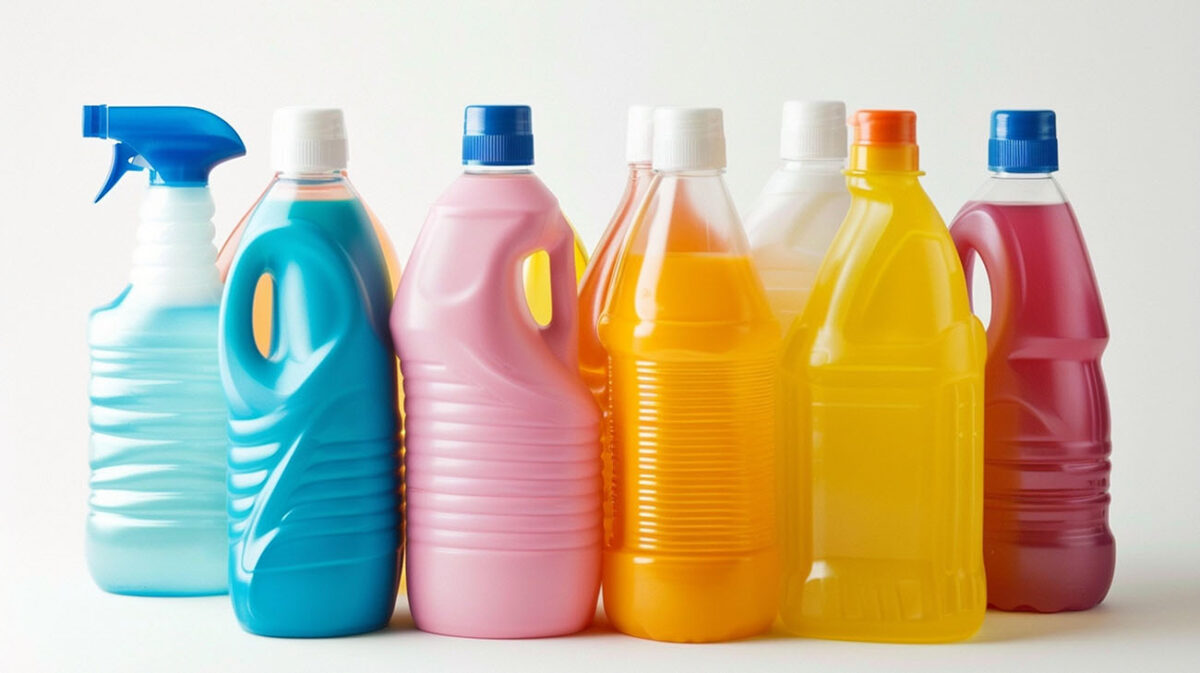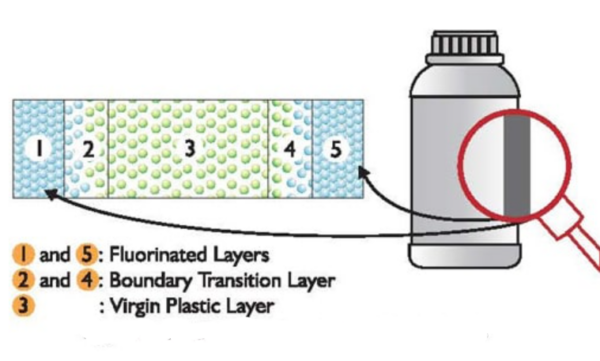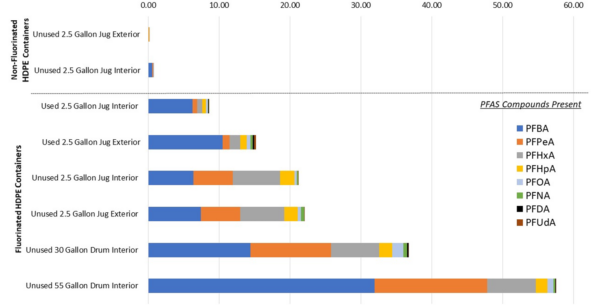Fluorination in Packaging and PFAS Contamination

Direct fluorination is a widely used surface treatment in the packaging industry to enhance barrier properties. However, it has recently been linked to PFAS contamination in HDPE and PP.
Direct fluorination replaces hydrogen atoms on a polymeric backbone with fluorine, creating a barrier against moisture and oxygen migration through polyethylene. This modification forms a protective layer between the packed liquid and plastic bottle walls. Additionally, the barrier strengthens the plastic, making fluorinated HDPE recyclable.
You can also read: Fluoropolymers Life Cycle and PFAS Contamination.
Why Fluorination in Packaging?
Manufacturers widely apply fluorination to enhance the barrier properties of plastic containers, enabling lighter packaging while maintaining strength and durability. Traditionally, they thickened container walls to avoid switching to more expensive multilayer materials. However, fluorination technology allows for reduced wall thickness in HDPE and PP containers, providing superior barrier properties with less material.
Fluorination is particularly beneficial for:
- Products that emit fumes: acetone, turpentine, paint thinners, kerosene, gasoline, lighter fluid.
- Household and agricultural products: fertilizers, weed killers, insecticides, household cleaning products.

Direct fluorination is a spontaneous surface treatment process in which hydrogens on a polymeric backbone are replaced with fluorine. This effectively creates a barrier to moisture and oxygen migration through the polyethylene. Courtesy of Bloom Seal Containers.
PFAS in Packaging
In 1983, the FDA approved polyethylene fluorination for food packaging to reduce oxygen and moisture migration, which can lead to food spoilage. However, this process can inadvertently generate PFAS, a group of chemicals associated with environmental and health risks. In January 2021, the EPA released a report indicating that PFAS are likely produced during plastic fluorination. The EPA later confirmed PFAS contamination in HDPE containers used for mosquito control pesticides, attributing it to the fluorination process.

Average level of PFAS in the rinsates from the non-fluorinated HDPE (top) and the fluorinated HDPE (bottom) containers and indicates that PFAS compounds are more abundant in the fluorinated containers than in the non-fluorinated containers. Courtesy of EPA’s Analytical Chemistry Branch PFAS Testing Rinses from Selected Fluorinated and Non-Fluorinated HDPE Containers.
Additionally, a University of Toronto researcher published findings in 2011 showing that fluorinated high-density polyethylene (HDPE) contains perfluorinated carboxylic acids (PFCAs), a type of PFAS. The amount of PFCAs formed on directly fluorinated HDPE is proportional to both the degree of fluorination and the oxygen levels within the fluorination chamber.
Challenges in Recycling Fluorinated HDPE
PFAS in HDPE packaging poses challenges, particularly in maintaining the quality and safety of post-consumer recycled (PCR) content for food-contact applications. Fluorinated HDPE is not labeled as such, potentially contaminating the recycling stream. Halogens like fluorine can damage equipment used in pyrolysis or other chemical-based recycling methods. This leads recyclers to limit the amount of chlorine and fluorine they accept.
Moreover, the pyrolysis of fluorinated plastic could form toxic fluorine-containing compounds. If fluorinated HDPE containers are mechanically recycled, any PFAS they contain will persist in the material. Mixing recycled materials with virgin plastic could result in PFAS-contaminated end products. Consequently, this raises serious environmental and health concerns.
Sources:
Is Fluorinating Polyethylene a Health Threat?
Perfluorinated Carboxylic Acids in Directly Fluorinated High-Density Polyethylene Material.
Rinses from Selected Fluorinated and Non-Fluorinated HDPE Containers.
